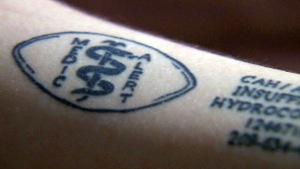Medical recordsMedical tattoos – a growing trend
Forget medical bracelets, a growing number of individuals with special medical needs have taken to tattooing their bodies to warn first responders about critical medical conditions; medical bracelets commonly list a person’s allergies, chronic diseases, and end-of-life wishes, but more and more people have started tattooing that information on their bodies

Tattoos listing medical conditions are becoming more popular // Source: tattoodonkey.com
Forget medical bracelets, a growing number of individuals with special medical needs have taken to tattooing their bodies to warn first responders about critical medical conditions.
Medical bracelets commonly list a person’s allergies, chronic diseases, and end-of-life wishes, but more and more people have started tattooing that information on their bodies.
Melissa Boyer, a diabetic, said she opted to get a 3.5 inch tattoo on her left forearm detailing her medical condition and allergies to penicillin and aspirin after years of losing and breaking medical bracelets.
“It’s been 29 years that I’ve had [diabetes], and I went through I-don’t-know-how-many bracelets,” Boyer told The Star. “I went and got the tattoo, and it made life easier.”
Echoing Boyer, Dr. Ed Friedlander, a pathologist in Kansas City, said, “Bracelets are nice, but something as strong as a tattoo … that is a strong statement.”
Dr. Friedlander has “No CPR” inked on the center of his chest where an emergency paramedic would see it. He explained that the tattoo is meant to emphasize his desire to avoid CPR in the event that his heart stops.
Medical tattoos are currently unregulated and it is unclear whether emergency responders would be obligated to honor them.
According to Dr. Saleh Aldasouqi, an endocrinologist at Michigan State University, the American Medical Association does not currently regulate medical tattoos, but Dr. Aldasouqi hopes that will soon change.
He has seen an increasing number of tattoos among his diabetic patients and believes that since they are growing in popularity the medical profession should step in and provide some uniformity.
As an example, he hopes to establish regulations where medical tattoos are made uniform or placed in the same area of the body, so first responders know where to search.
“My perspective is that we as physicians need to be involved in this,” Dr. Aldasouqi said.
“My intention has been to bring this issue to the surface so that medical organizations can have a say in that,” he said. “When you just Google it, you’re going to find hundreds of stories and discussions, but no medical say. So I feel we leave our patients kind of afloat.”
Dr. Aldasouqi does not necessarily advocate for or against the tattoos, but believes that patients should discuss them with their doctors beforehand.
Ramesh Srinivasan, a spokesperson for the MedicAlert Foundation, which sells more than 100,000 pieces of medical jewelry a year, believes that tattoos will never replace medical alert jewelry. In an interview with The Star, Srinivasan said that unlike tattoos, MedicAlert jewelry provides a “complete snapshot” of an individual’s health and their medical conditions.
